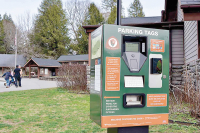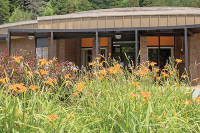Holing up is common for poisonous snakes in winter
Where do the poisonous snakes go in winter?
In the Smokies region we have two poisonous species: timber rattlesnakes and copperheads. Cottonmouth moccasins are often reported, but that species is found no farther inland than about the fall line, which demarcates the outer piedmont from the inner coastal plain. I suspect those reporting and killing what they think are cottonmouths are actually encountering northern watersnakes, a species that is aggressive in and around water, but not poisonous.
The northern copperhead is the most common by far of our poisonous snakes, being found in a variety of habitats from the lowest elevations to over 4,000 feet. But they’re not as frequent above 2,500 feet. Copperheads are stout-bodied, averaging about 24 to 30 inches in length. One more than four feet is rare. The national record is just over 53 inches. Immature copperheads have a bright greenish-yellow tail. Adults have brown or chestnut, hourglass-shaped crossbands over a brown, tan, or pinkish body color. The top of the head has large symmetrical coppery-red to yellowish-brown plates. Under most circumstances, this natural camouflage makes the serpent virtually invisible.
Timber rattlesnakes are not nearly so common as copperheads in settled areas. They’re found from the lowest elevations up to 6,000 feet, but are rare in the spruce-fir country. Like the copperhead, they generally prefer rocky habitats. In summer, however, rattlers seek prey throughout the forests, meadows, and farmlands of the Blue Ridge, frequently “holing up” in old stumps. Rattlers are heavy-bodied, averaging 36 to 54 inches in length. A five-foot specimen is unusual. The national record is about 75 inches. There are two color phases: a yellow phase with wavy crossbands down the back over a body color of yellow, brown, or gray; and a black phase with a dark, olive-brown cast that conceals most if not all of the body color.
In winter, serpents in cold climates find shelter in holes or burrows or hollow logs or caves or basements and spend the winter in an inactive state similar to hibernation. As many as 100 mixed species individuals have been reported from a single site. In early spring, they emerge and begin sunning. When temperatures stay above freezing, they move into summer ranges and birthing areas as far away from the hibernaculum as five miles. As winter approaches, they return, when possible, to the previous year’s den. If a sudden cold snap catches them, they may either die or be fortunate and find a suitable secondary den. A number of species sometimes share the same den, especially black rat snakes, timber rattlesnakes and copperheads. The black rat snake is often referred to as the “pilot’s nake because it is supposed it “pilots” the way for the others to the den in winter and away from the den in spring. Baby timber rattlesnakes are often birthed at some distance from their “parental” hibernaculum, requiring fall migration to a previously unvisited location. Studies have suggested that scent trails laid down by related species guide them “home.”
George Ellison wrote the biographical introductions for the reissues of two Appalachian classics: Horace Kephart’s Our Southern Highlanders and James Mooney’s History, Myths, and Sacred Formulas of the Cherokees. In June 2005, a selection of his Back Then columns was published by The History Press in Charleston as Mountain Passages: Natural and Cultural History of Western North Carolina and the Great Smoky Mountains. Readers can contact him at P.O. Box 1262, Bryson City, N.C., 28713, or at This email address is being protected from spambots. You need JavaScript enabled to view it..





